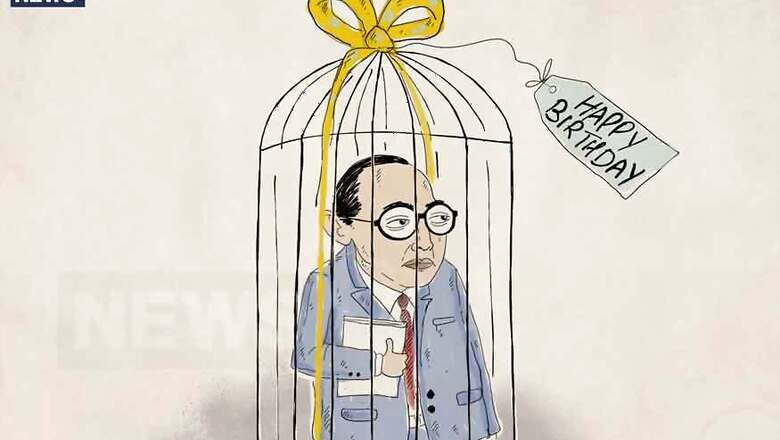
views
#BeingADalit is a series on what it takes to be a persecuted minority in India. In an attempt to go beyond the numbers, News18 also mapped incidents of Dalit atrocities over the last one year across India.
The practice of untouchability is outlawed by the constitution of India. It is the oldest system of degradation of human beings. And, it is still practised in rural, as well as in urban India. It is also evident that the degree of assertion has risen among the Scheduled Castes all over India. They are resisting the graded hierarchy and inequality by all means possible.
The leader of this remarkable revolution, Babasaheb Ambedkar, never advocated violence. He brought radical changes in the lives of millions of people without shedding a drop of blood. He is the tallest non-violent revolutionary in the history of world. He fought against the gross violation of the human rights with peaceful means. The Ambedkarite movement is infused with ethos taught and practiced by Babasaheb Ambedkar. The movement is increasingly influenced by Buddhism: the religion of peace and human enlightenment following the great conversion movement launched by Babasaheb Ambedkar in 1956. For example, when the Caste Hindutva mob flogged the four youths in Una in Gujarat in 2016, the masses came out with flags of Buddhism during their agitations. The four youths declared that they will leave Hinduism and embrace Buddhists on 14th April 2018. When Rohith Vemula was forced to commit suicide, his mother, Radhika Vemula, embraced Buddhism. When violence took place in Saharanpur in 2017, Dalits in UP took to the streets with Buddhist flags and openly embraced Buddhism. This is also seen in the recent mobilization of masses aftermath the attack on Bhima-Koregaon by the Hindutva brigade.
The resurgent Buddhism is the symbol of radical transformation in modern India. Buddhism has become the mainstream religion after a gap of many centuries. Besides Scheduled Castes, the Tribals and OBCs are gradually turning towards it. Buddhism is holding the banner of democracy. It is playing an important role in the peaceful democratisation of India. But why are the masses inclined towards Buddhism?
The Buddha realized that without equality in the society it is impossible to create a peaceful and harmonious society. The Buddha stood for equality, not only between men and women, but also between individuals irrespective of their social, economic, and political backgrounds. He envisioned a casteless and classless society. His quest was to annihilate hierarchy in every form. When he constituted his Sangha, equality was the organising principle of his community-- thus creating a prototype of the society so that the larger community can emulate how to relate with each other on the basis of equality, respect, and dignity.
According to Babasaheb Ambedkar, the revolution of the Buddha transformed the world. The Buddha’s revolution infused with equality, peace, and justice was countered with the Brahminical onslaught on Buddhism. Ambedkar described this process in Revolution and Counterrevolution in Ancient India. Babasaheb Ambedkar defined Indian history, citing Nesfield, as the history of mortal conflict between Buddhism and Brahminism.
Babasaheb Ambedkar, in his another extensively researched and well-argued book on the origin of the untouchability, cites the reasons which led to the practice of untouchability. One of his key findings was that ”untouchables” throughout India were formerly Buddhists. Long before Babasaheb Ambedkar, Iyothee Thass, the leader of the Buddhist movement in South India, proved the same theory. Since then, many social reformers have argued that Buddhism was the religion of their ancestors.
Babasaheb Ambedkar embraced Buddhism not only to bring his people out of the drudgery of caste-- that Hinduism so vehemently promotes, but to also give them back their dignified identity as the followers of the Enlightened Ones. Since the beginning of his public career, Babasaheb Ambedkar argued that ‘untouchables’were not Hindus. When he decided to leave Hinduism in 1935, he held massive consultations with his community and in one of the biggest community gatherings in 1936, he encouraged his people that they should bear the message of the Buddha in their minds: Be your own light. He found Buddhism compatible with democracy and science. His social philosophy based on liberty, equality, and fraternity can be traced to his understanding of the Buddha and His Dhamma.
Babasaheb Ambedkar is now well-known all over the Buddhist world as the founding father of Socially-Engaged Buddhism. Since his conversion movement in 1956, millions have followed in his footsteps. The conversion which took place in Maharashtra in 1956 paved a way towards new culture, new rituals, and a new society based on the values taught by the Buddha. The "untouchable" Mahars have moved farther away from Hinduism with the Buddhist cultural revolution. They have severed their ties with the religion that treated them less than the humans. With the surging Ambedkarite movement all over India, the oppressed classes in India are turning towards Buddhism. The population of Buddhists is rising dramatically all over India. In 2006, the untouchable communities embraced Buddhism all over India. The wave of conversion swept India in 2006. Buddhism has become an important aspect of the social transformation in India.
The rejection of the negative identity forced upon them by the caste-based Hinduism and embracing the positive identity based on their historical linkages with Buddhism has become the most important emancipatory tool for India's oppressed. The communities that converted to Buddhism have made progress in several areas all over India and made their significant presence felt in civil services and other professional areas.
According to census data of 2011, the Buddhists have better social indicators compared to those who did not convert to Buddhism among the Scheduled Castes. In case of literacy, the Buddhists have higher literacy rate than the national average. Buddhists have a literacy rate of 81.29%, higher than the national average of 72.98%. According to Indiaspend, the literacy rate among Hindus is 73.27% while Scheduled Castes have a lower literacy rate of 66.07%. In Uttar Pradesh, which is considered as one of the backwards states of India have 68.59% literacy rate among the Buddhists, higher than population average (67.68%) and nearly eight percentage points higher than the figure for other Scheduled Castes (60.88%).
Buddhism offers much needed confidence and dignity to the people who are forced to feel inferior and condemned by the caste-based social order. This confidence is evident in their rise from the hell of caste and their advent into the land of confidence and dignity. Buddha, after all, taught that the freedom of mind and wisdom is not privy to a class of people, it can be attained by all who struggle and strive to transform not only themselves, but also the people around them.
(Mangesh Dahiwale is a social activist based in Pune. Views are personal )




















Comments
0 comment